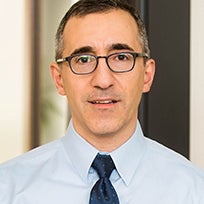
Subscribe to Pittwire Today
Get the most interesting and important stories from the University of Pittsburgh.Pitt Experts Optimistic About Vaccine Candidate’s Efficacy, Advise People Continue Protecting Themselves
Today, pharmaceutical company Pfizer released early data from its coronavirus vaccine trial showing it is more than 90% effective against the disease. The vaccine uses mRNA to trigger an immune response in the body—a different approach than traditional vaccines—and was given to more than 40,000 people around the world.
University of Pittsburgh medical experts said they are cautiously optimistic about the latest development.
“It’s rather interesting and very significant because this type of vaccine that Pfizer is working on is a very different vaccine compared to what we are used to licensing. There has been no vaccine of its type ever licensed before,” said Paul Duprex, director of Pitt’s Center for Vaccine Research. “Up until today the curtains were closed. We haven’t swung the curtains open fully, but we’ve gotten a little peek. And we see it’s bright outside.”
The Center for Vaccine Research is working on its own vaccine using a measles vector in collaboration with the Serum Institute of India. Pitt is also running three local sites for COVID-19 vaccine trials for Operation Warp Speed by Moderna, AstraZeneca and J&J. In light of the Pfizer news, Duprex said people should remember that they are only looking at one part of a puzzle.
“We don’t know if this vaccine will protect people from becoming infected and transmitting the virus to others,” said Duprex, who is also a professor of microbiology and molecular genetics at Pitt. “Big progress comes from small steps. This is the first peek to see what these candidate COVID-19 vaccines are doing when they’re tested in large numbers of people.”
Walid Gellad, director of the University of Pittsburgh Center for Pharmaceutical Policy and Prescribing, told Reuters one thing that’s “highly encouraging” is that science can now create a vaccine in a relatively short amount of time and test it, which “gives a lot of hope for the future when these things happen again.”
“This is a hint that these mRNA vaccines are likely to work, and there’s at least one other. And they’re likely to be safe, at least from this trial,” said Gellad, who is also associate professor of medicine, health policy and management.
Anita McElroy, assistant professor of pediatrics at Pitt and member of the Center for Vaccine Research, noted on KDKA newsradio that the vaccine still has to be approved by the U.S. Food and Drug Administration (FDA) before being available to the public.
“The company will take their data to the FDA and the FDA will review it and make a decision about whether they want to give emergency use authorization. If they do, that vaccine should be available for people to get,” she said.
McElroy also said manufacturing may be a challenge and that there won’t be enough doses available at first.
“I think there will be discussion on who gets the vaccine first,” she said. “Senior citizens, health care workers and immunocompromised people would probably be near the top of the list.”
While Pfizer’s vaccine is in Phase 3 trials and could be approved for use this month, observation will continue for two years afterward. For the 10% of people it has failed, John Mellors, Distinguished Professor of Medicine at Pitt, said the reason is still unclear. He also noted any therapy or vaccine will not be 100% effective.
“The closest we came was in treatment of hepatitis C. Many trials showed above 95% efficacy. And that’s about as good as we can do. We’ve been through a period of great difficulty,” he said. “I have no doubt that in time biomedical science is going to prevail. Let’s not let politics get in the way. Let biomedical science drive what needs to be done.”
Mellors meanwhile advised people not let their guard down, especially with COVID-19 cases in the U.S. reaching an all-time high of 10 million as of this writing.
“The risk is higher right now in the U.S. than at any time in this pandemic. There looks like there’s light at the end of the tunnel, so just stick with it for the next many months until we can get vaccinated,” he said. “It’s a transmission chain. If we block that chain and prevent infection by wearing a mask, then we can save lives.”





